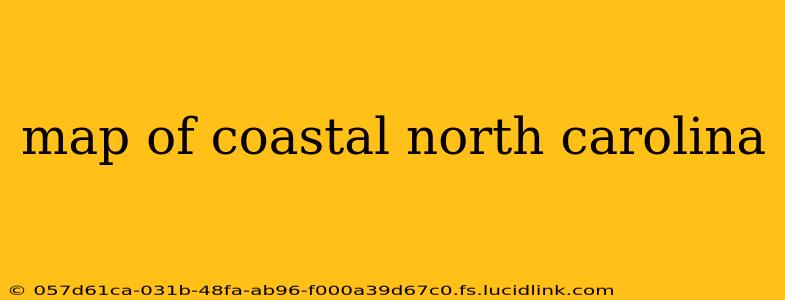North Carolina's coastline boasts a captivating blend of natural beauty, rich history, and vibrant culture. From the majestic Outer Banks to the serene sounds, exploring this area requires understanding its geography. This guide will delve into the coastal map of North Carolina, highlighting key features and answering frequently asked questions. Whether you're planning a vacation, researching local history, or simply curious about this stunning region, you'll find valuable insights here.
What are the main geographic features of the North Carolina coast?
The North Carolina coast is incredibly diverse. Its primary geographic features include:
-
The Outer Banks: A chain of barrier islands stretching approximately 200 miles along the Atlantic Ocean. These islands are known for their wild beauty, lighthouses, and historical significance. They offer a stark contrast to the calmer sounds.
-
The Sounds: Protected bodies of water located between the Outer Banks and the mainland. These shallow, brackish waters, including Pamlico Sound and Albemarle Sound, are rich in marine life and offer opportunities for boating, fishing, and birdwatching.
-
The Coastal Plain: The mainland area adjacent to the sounds, characterized by flat, low-lying terrain. This region is marked by rivers, swamps, and diverse ecosystems.
-
Cape Hatteras: A prominent cape situated on Hatteras Island, known for its powerful currents and historic lighthouse. This area is particularly vulnerable to hurricanes and erosion.
-
Cape Lookout: Another significant cape located south of Hatteras, also known for its lighthouse and rugged beauty.
What are the major cities and towns along the North Carolina coast?
Several significant cities and towns dot the North Carolina coastline, each offering its own unique character and attractions:
-
Wilmington: A major port city with a rich maritime history, known for its Riverwalk, beautiful beaches, and thriving arts scene.
-
Morehead City/Atlantic Beach: A popular destination with beautiful beaches, a working waterfront, and access to excellent fishing opportunities.
-
Outer Banks Towns: Numerous charming towns and villages are scattered along the Outer Banks, including Kitty Hawk, Kill Devil Hills, Nags Head, and Manteo, each offering a distinct atmosphere.
-
Beaufort: A historic town known for its charming waterfront, rich history, and access to the Crystal Coast.
-
Emerald Isle: A popular vacation destination on the Crystal Coast, known for its beautiful beaches and family-friendly atmosphere.
How can I find a detailed map of the North Carolina coast?
Many resources provide detailed maps of the North Carolina coast. Online map services like Google Maps, Bing Maps, and MapQuest offer interactive maps with street views, satellite imagery, and points of interest. You can also find detailed topographical maps and nautical charts from sources like the National Oceanic and Atmospheric Administration (NOAA). Printed maps are also available at bookstores, visitor centers, and outdoor retailers. Remember to consider the level of detail you need for your specific purpose when choosing a map.
What are some popular activities along the North Carolina coast?
The North Carolina coast offers a wide array of activities:
-
Beaches: Relaxing on the sandy shores, swimming, sunbathing, and surfing are always popular.
-
Fishing: Both inshore and offshore fishing opportunities abound, targeting species like speckled trout, red drum, and flounder.
-
Boating: Exploring the sounds and inlets by boat provides a unique perspective of the coastal environment.
-
Kayaking/Paddleboarding: These activities offer a peaceful way to explore the sounds and waterways, encountering diverse wildlife.
-
Wildlife Viewing: The coastal region boasts a rich variety of birdlife, marine mammals, and other wildlife. Birdwatching and dolphin watching tours are commonly available.
-
Historical Sites: Explore lighthouses, historic towns, and museums to learn about the region's rich history.
Are there any specific hazards I should be aware of when visiting the North Carolina coast?
Visitors should be aware of several potential hazards:
-
Hurricanes: The coastal region is prone to hurricanes, especially during the late summer and fall months. Staying informed about weather forecasts is crucial.
-
Rip Currents: Strong rip currents can be dangerous for swimmers. Always heed lifeguard warnings and swim in designated areas.
-
Sun Exposure: The intense sun can cause sunburn and heatstroke. Use sunscreen, wear protective clothing, and stay hydrated.
-
Mosquitoes: Mosquitoes can be prevalent in certain areas, especially near swamps and marshes. Use insect repellent.
-
Wildlife Encounters: Be aware of potential encounters with wild animals, including sharks, jellyfish, and venomous snakes. Maintain a safe distance and respect their habitat.
By understanding the diverse geography, major towns, and potential hazards, you can fully appreciate the beauty and wonder of North Carolina's captivating coast. Happy exploring!
